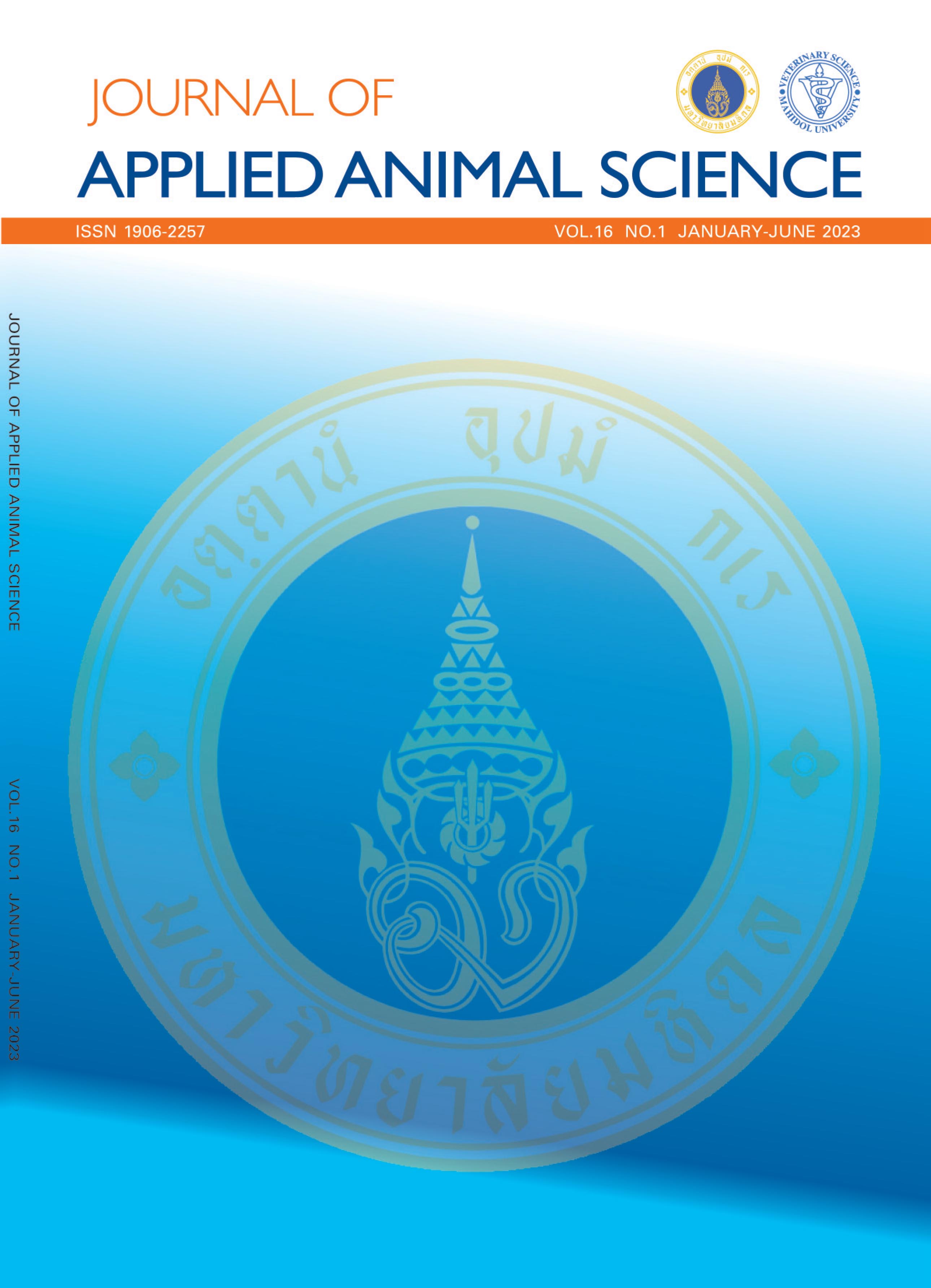Partial Cystectomy and Ureteroneocystostomy in a Dog with Urinary Bladder Squamous Cell Carcinoma
Keywords:
Bladder cancer, Dog, Partial cystectomy, Squamous cell carcinomaAbstract
Squamous cell carcinoma (SCC) is a rare type of urinary bladder carcinoma in dogs. A 10-year-old spayed bitch was presented with pollakiuria. Ultrasonography revealed right obstructive hydronephrosis and proximal hydroureter. Urinary bladder wall thickening and an irregular mucosal surface were presented. Partial cystectomy and ureteroneocystostomy of the right ureter were performed for urinary bladder mass removal in the area close to the right ureteral opening. The histopathological characteristics of urinary bladder SCC were confirmed by negative immunohistochemical staining of uroplakin III, cytokeratin 7, and cytokeratin 20. Two months after surgery, multiple nodules in all hepatic lobules were presented from ultrasonography. The distant metastasis was suspected. This report demonstrates the diagnostic approach and management of urinary bladder SCC, a rare type of canine urinary bladder cancer.
References
Burgess KE, DeRegis CJ. Urologic Oncology. Vet Clin North Am Small Anim Pract. 2019;49(2):311-23.
Clerc-Renaud B, Gieger TL, LaRue SM, Nolan MW. Treatment of genitourinary carcinoma in dogs using nonsteroidal anti-inflammatory drugs, mitoxantrone, and radiation therapy: A retrospective study. J Vet Intern Med. 2021;35(2):1052-61.
de Brot S, Robinson BD, Scase T, Grau-Roma L, Wilkinson E, Boorjian SA, et al. The dog as an animal model for bladder and urethral urothelial carcinoma: Comparative epidemiology and histology. Oncol Lett. 2018;16(2):1641-9.
Fulkerson CM, Knapp DW. Tumors of the urinary system. In: Vail DM, Thamm DH, Liptak JM, editors. Withrow and MacEwen's Small Animal Clinical Oncology. Tumors of the Urinary System. St. Louis (MO): W.B. Saunders; 2019. p. 645-56.
Kates M, Gorin MA, Deibert CM, Pierorazio PM, Schoenberg MP, McKiernan JM, et al. In-hospital death and hospital-acquired complications among patients undergoing partial cystectomy for bladder cancer in the United States. Urol Oncol. 2014;32(1):53 e9-14.
Lopez-Beltran A, Requena MJ, Alvarez-Kindelan J, Quintero A, Blanca A, Montironi R. Squamous differentiation in primary urothelial carcinoma of the urinary tract as seen by MAC387 immunohistochemistry. J Clin Pathol. 2007;60(3):332-5.
Manley KV, Hubbard R, Swallow D, Finch W, Wood SJ, Biers SM. Risk factors for development of primary bladder squamous cell carcinoma. Ann R Coll Surg Engl. 2017;99(2):155-60.
Martin JW, Carballido EM, Ahmed A, Farhan B, Dutta R, Smith C, et al. Squamous cell carcinoma of the urinary bladder: Systematic review of clinical characteristics and therapeutic approaches. Arab J Urol. 2016;14(3):183-91.
Ploypetch S, Maneein S, Phantharangsi S. Computed tomographic appearance of bladder and vaginal leiomyoma in dog: case report. Thai J Vet Med. 2021;51(4):809-14.
Ramos-Vara JA, Miller MA, Boucher M, Roudabush A, Johnson GC. Immunohistochemical detection of uroplakin III, cytokeratin 7, and cytokeratin 20 in canine urothelial tumors. Vet Pathol. 2003;40(1):55-62.
Ricardo Huppes R, Crivellenti LZ, Barboza De Nardi A, Roque Lima B, Alves Cintra C, Luiz Costa Castro J, et al. Radical cystectomy and cutaneous ureterostomy in 4 dogs with trigonal transitional cell carcinoma: description of technique and case series. Vet Surg. 2017;46(1):111-9.
Richie JP, Waisman J, Skinner DG, Dretler SP. Squamous carcinoma of the bladder: treatment by radical cystectomy. J Urol. 1976;115(6):670-2.
Rungsipipat A, Sunyasootcharee B, Ousawaphlangchai L, Sailasuta A, Thanawongnuwech R, Teankum K. Neoplasms of dogs in Bangkok. Thai J Vet Med. 2003;33(1):59-66.
Schrempp DR, Childress MO, Stewart JC, Leach TN, Tan KM, Abbo AH, et al. Metronomic administration of chlorambucil for treatment of dogs with urinary bladder transitional cell carcinoma. J Am Vet Med Assoc. 2013;242(11):1534-8.
Stein JP, Lieskovsky G, Cote R, Groshen S, Feng AC, Boyd S, et al. Radical cystectomy in the treatment of invasive bladder cancer: long-term results in 1,054 patients. J Clin Oncol. 2001;19(3):666-75.
Suwankanit K, Manee-in S. Treatment of transitional cell carcinoma of urinary bladder using meloxicam in a dog: a case report. J Appl Anim Sci. 2018;11(2): 45-56.
Zahoor H, Elson P, Stephenson A, Haber GP, Kaouk J, Fergany A, et al. Patient characteristics, treatment patterns and prognostic factors in squamous cell bladder cancer. Clin Genitourin Cancer. 2018; 16(2):e437-e42.
Downloads
Published
How to Cite
Issue
Section
License
Copyright (c) 2023 Mahidol University Faculty of Veterinary Science

This work is licensed under a Creative Commons Attribution-NonCommercial-NoDerivatives 4.0 International License.
Published articles are under the copyright of the Journal of Applied Animal Science (JAAS) effective when the article is accepted for publication. The editorial boards claim no responsibility for the content or opinions expressed by the authors of individual articles in this journal. Partially or totally publication of an article elsewhere is possible only after the consent from the editors.



